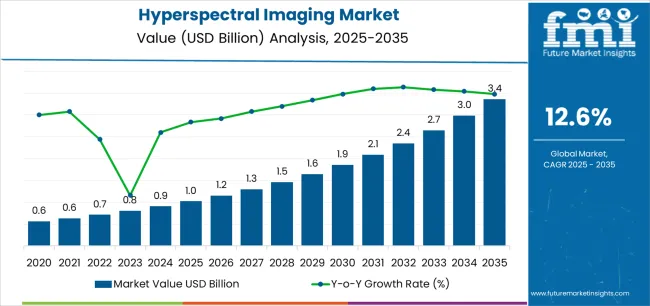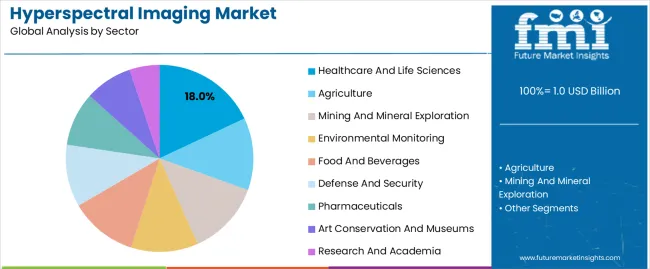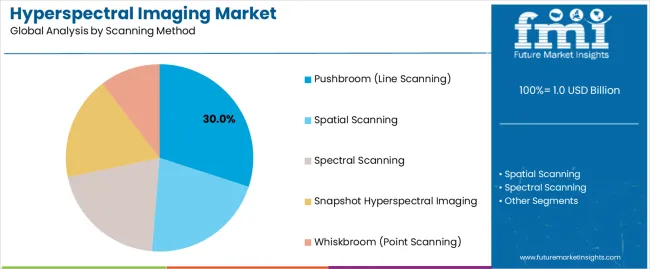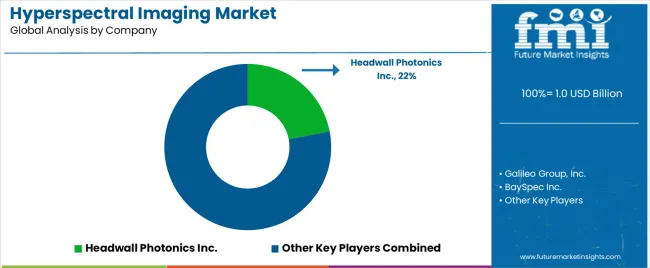The Hyperspectral Imaging Market is estimated to be valued at USD 1.0 billion in 2025 and is projected to reach USD 3.4 billion by 2035, registering a compound annual growth rate (CAGR) of 12.6% over the forecast period.
The Hyperspectral Imaging market is witnessing steady growth driven by its expanding applications in healthcare, life sciences, agriculture, and industrial inspection. Increasing demand for non-invasive diagnostic techniques, precise material analysis, and quality control solutions is fueling market expansion. The future outlook for this market is shaped by advancements in imaging sensors, data processing algorithms, and integration with AI and machine learning technologies.
Rising awareness of early disease detection, personalized medicine, and advanced research in life sciences is creating opportunities for hyperspectral imaging solutions. Additionally, the development of compact and portable hyperspectral systems is enabling broader adoption across laboratories and field applications.
The market is further supported by increased investment in healthcare infrastructure, research initiatives, and technology-driven monitoring solutions As the need for accurate, high-resolution imaging continues to rise, hyperspectral imaging is anticipated to play a key role in enhancing analytical capabilities, improving operational efficiency, and supporting research and development efforts across diverse sectors, providing sustained growth potential in both established and emerging markets.

| Metric | Value |
|---|---|
| Hyperspectral Imaging Market Estimated Value in (2025 E) | USD 1.0 billion |
| Hyperspectral Imaging Market Forecast Value in (2035 F) | USD 3.4 billion |
| Forecast CAGR (2025 to 2035) | 12.6% |
The market is segmented by Sector and Scanning Method and region. By Sector, the market is divided into Healthcare And Life Sciences, Agriculture, Mining And Mineral Exploration, Environmental Monitoring, Food And Beverages, Defense And Security, Pharmaceuticals, Art Conservation And Museums, and Research And Academia. In terms of Scanning Method, the market is classified into Pushbroom (Line Scanning), Spatial Scanning, Spectral Scanning, Snapshot Hyperspectral Imaging, and Whiskbroom (Point Scanning). Regionally, the market is classified into North America, Latin America, Western Europe, Eastern Europe, Balkan & Baltic Countries, Russia & Belarus, Central Asia, East Asia, South Asia & Pacific, and the Middle East & Africa.

The healthcare and life sciences sector is projected to hold 18.0% of the hyperspectral imaging market revenue share in 2025, establishing it as a leading application segment. This growth is driven by the increasing use of hyperspectral imaging for non-invasive diagnostics, early disease detection, and biomedical research.
The technology allows detailed visualization of tissue composition, molecular signatures, and chemical variations, which supports enhanced clinical decision-making and research outcomes. Rising investments in personalized medicine and advanced healthcare infrastructure have further accelerated the adoption of hyperspectral imaging in laboratories and hospitals.
Additionally, the growing focus on efficient and accurate diagnostic workflows has reinforced the prominence of this sector, as hyperspectral systems provide reliable, high-resolution imaging data for medical analysis and research purposes The integration of AI-driven data processing also enhances predictive insights, operational efficiency, and treatment planning, solidifying the role of healthcare and life sciences as a leading segment in the market.

The pushbroom scanning method is expected to account for 30.0% of the hyperspectral imaging market revenue share in 2025, making it the leading scanning method. Its growth is attributed to the ability to capture high-resolution spectral data across a wide field of view, enabling precise analysis of materials and biological samples.
Pushbroom systems provide superior spatial and spectral fidelity, which is critical for applications in healthcare, life sciences, and industrial quality control. The method’s efficiency in data acquisition and its compatibility with advanced processing algorithms allow real-time imaging and analysis, enhancing operational productivity.
Additionally, the adaptability of pushbroom scanners to integrate with laboratory and field-based imaging setups has increased their adoption across diverse sectors Continuous improvements in sensor technology, coupled with the rising demand for detailed and accurate spectral information, have reinforced the prominence of the pushbroom scanning method as the preferred choice in the hyperspectral imaging market.
Medical Diagnostics and Life Sciences Sector to Implement Hyperspectral Imaging Profiting Sales
Hyperspectral imaging technology offers potential for non-invasive and real time analysis of biological tissues. This technique is valuable for medical diagnosis and research. Thus by capturing detailed spectral information from tissues this technology can help in early detection of diseases. This technology helps in detecting cancer and assists in surgical procedures by differentiating healthy and abnormal tissues. This technology is used in life science sector for studying cellular structures and analyzing biological processes. This increasing popularity of hyperspectral imaging’s capabilities in healthcare and life sciences is soaring the growth and overall development of this industry.
Advancements in Hyperspectral Camera Technology to accelerate Scope for Imaging Technology in varied Applications
Development of compact, lightweight, and high resolution hyperspectral cameras have made this technology more accessible and cost effective. This technology with camera advancements open scope for various industries. Improvement in data processing algorithms and software have enhanced efficiency of image analysis. It is enabling faster interpretation and extraction of valuable insights.
Technological advancements have opened scope for usage of hyperspectral imaging beyond traditional research and defense applications. This is leading to its adoption in agriculture, food quality assessment, mining, and infrastructure inspection industries. These ongoing advancements in technological have made technicalities accessible to wide range of users have propelled the adoption of this imaging techniques.
Precision Agriculture and Environmental Monitoring to Prosper Hyperspectral Imaging Market
This imaging enables farmers to obtain detailed information about crop health, soil conditions, and vegetation growth. Using hyperspectral cameras mounted on drones or satellites farmers can accurately monitor their fields. They can optimize fertilization and irrigation and detect early signs of diseases or pests.
Hyperspectral imaging in environmental monitoring is being utilized to assess vegetation health and map ecosystems. They can also monitor water quality. This imaging can provide precise and comprehensive data for agricultural and environmental landscape. This adoption by fast paced and broader sector can fuel the growth of hyperspectral imaging market globally.
Challenges in the Hyperspectral Imaging Market
Analysis of hyperspectral data require advance knowledge in remote sensing and spectral analysis. Henceforth, the requirement of computational resources, skilled, and experienced technicians may limit pool of qualified professionals.
Another hurdle in the growth is complexity of the imaging technology and higher operational costs for businesses. Also, ensuring data and security pose roadblocks in the development of infrastructure and software solutions.
The global hyperspectral imaging market was projected a markup in sensor technology with developmental and advancement in high resolution imaging techniques. During pandemic, the industry have faced bad fall with global lockdown and shutdown of all the properties. This had very severe impact on its overall revenue and even did demolish many grounds to shutdown permanently.
With recovery in the past few years many investors and developers established several AI integrated and advanced technology imaging systems to grow and explore various applications. Advancement in hyperspectral imaging did make huge difference in agricultural and healthcare sector. Industries like mining and environmental monitoring did see many changes in past decade. Adoption of this technology was an indispensable asset for businesses and organizations looking for optimized solution.
Integration of AI and data analytics advanced operating processing in various sectors. Replacing traditional technique and time saving methods have accelerated the adoption and scope for advanced tool like hyperspectral imaging. Also growth in agricultural and health sector using this technique have generated huge revenues in the overall scenario of global landscape.
Below data summarizes regions expanding globally hyperspectral imaging market. Market share and recent development with their current trends are mentioned below. North America is at forefront of this development in this industry with expertise in technology and giant tech ecosystem. Following Asian region with fast paced growth in technological segment with growing tech savvy population.
| Region | Market Share (%) |
|---|---|
| North America | 35% |
| East Asia | 20% |
North America's hyperspectral imaging market is experiencing significant growth. Increased government funding for research fuels this expansion. The defense sector, too, heavily invests in this technology.
Environmental monitoring agencies in the United States are also adopting these solutions for precise data collection. Besides this, healthcare institutions use it for advanced medical diagnostics.
The demand for these solutions is also seen in the agriculture industry as they employ it for crop health assessment. The region's focus on precision agriculture boosts market growth. Stringent regulations for food quality control also necessitate hyperspectral solutions.
East Asia's hyperspectral imaging market is rapidly expanding as the region's booming electronics industry drives technological advancements. China's space programs heavily utilize hyperspectral imaging capabilities.
Japan leads in miniaturizing hyperspectral sensors for consumer electronics while South Korea integrates this technology into smartphone cameras. The region's manufacturing sector also adopts these technologies for quality control.
Environmental concerns in densely populated areas have also accelerated their adoption. Precision farming in rice cultivation also benefits from hyperspectral analysis.
Governments are also found to be investing in hyperspectral technology for urban planning. The region's rapid industrialization creates new market opportunities. Apart from this, East Asia's focus on AI integration enhances hyperspectral data analysis.
Below given data projected leading segment of the industry with their respective share values.
Hyperspectral imaging enables healthcare professionals to acquire intricate tissue and cellular data. This technique helps in early detection of diseases and provides critical insights into physiological and pathological characteristics of tissues. Medical professionals across the globe are utilizing this imaging to enhance accuracy of diagnoses and treatment planning. This improves patient outcome and best analysis. Healthcare and life sciences segment has accounted value share of 18.0% in the hyperspectral imaging market in 2025.
| Segment | Healthcare and Life Sciences (Sector) |
|---|---|
| Value Share | 18.0 % |
Integration of hyperspectral imaging into surgical procedures and medical imaging systems have made a remarkable shift in precise, personalized, and effective patient care. This technique have accelerated the outcomes and overall process of healthcare and life sector. This technology have revalorized pathology, surgery, and non-invasive diagnostics with its exceptional qualities. Thus this technology have positioned itself as important driver for transformative advancement in medical research and clinical practices.
Pushbroom scanning method offers exceptionally high spectral and spatial resolution. It provides a level of precision that is advantageous in agriculture, environmental monitoring, and healthcare. Push broom scanning method enables efficient data collection over large areas. This make it ideal choice for application like precision agriculture.
| Segment | Pushbroom (Scanning Method) |
|---|---|
| Value Share | 30.0 % |
Pushbroom scanning method have acquired share value of 30% in global hyperspectral imaging market. This method stands out for its ability to seamlessly integrating with advanced data analysis technologies like AI and machine learning algorithms. This integration empowers businesses and organization to derive meaningful insights from hyperspectral data. This is propelling advancements in fields ranging from mining to healthcare.

Developers in this industry to define its working in varied sectors. Key players should leverage technological advancements to capture and analyze wide spectrum of light for detailed information across various applications. Players should work on making systems more compact, cost effective and accessible to wider audience.
Startups like FlyGuys, Gamaya, GeologicAI, and Pixxel have immensely expanded in this landscape. They have introduced innovative solutions catering to diverse industry needs. Startups like Pixxel and GeologicAI have democratized access to hyperspectral imaging through their products and services. They have made it more accessible and applicable in real world scenarios.
Industry Update
Hyperspectral imaging industry is applied to agriculture, mining and mineral exploration, environmental monitoring, healthcare and life sciences, food and beverages, defense and security, pharmaceuticals, art conservation and museums, and research and academia sectors.
The segment is categorized into spatial scanning, spectral; scanning, snapshot hyperspectral imaging, pushbroom (line scanning), and whiskbroom (point scanning).
A regional analysis has been carried out in key countries of North America, Latin America, Asia Pacific, Middle East and Africa (MEA), and Europe.
The global hyperspectral imaging market is estimated to be valued at USD 1.0 billion in 2025.
The market size for the hyperspectral imaging market is projected to reach USD 3.4 billion by 2035.
The hyperspectral imaging market is expected to grow at a 12.6% CAGR between 2025 and 2035.
The key product types in hyperspectral imaging market are healthcare and life sciences, agriculture, mining and mineral exploration, environmental monitoring, food and beverages, defense and security, pharmaceuticals, art conservation and museums and research and academia.
In terms of scanning method, pushbroom (line scanning) segment to command 30.0% share in the hyperspectral imaging market in 2025.






Full Research Suite comprises of:
Market outlook & trends analysis
Interviews & case studies
Strategic recommendations
Vendor profiles & capabilities analysis
5-year forecasts
8 regions and 60+ country-level data splits
Market segment data splits
12 months of continuous data updates
DELIVERED AS:
PDF EXCEL ONLINE
Hyperspectral Imaging Camera Market Size and Share Forecast Outlook 2025 to 2035
Hyperspectral Imaging for Seal Integrity Market Analysis Size and Share Forecast Outlook 2025 to 2035
Medical Hyperspectral Imaging Market - Growth, Demand & Forecast 2024 to 2034
Imaging Markers Market Analysis - Size, Share, and Forecast Outlook 2025 to 2035
3D Imaging Surgical Solution Market Size and Share Forecast Outlook 2025 to 2035
Gel Imaging Documentation Market Size and Share Forecast Outlook 2025 to 2035
PET Imaging Workflow Market Analysis - Size, Share, and Forecast Outlook 2025 to 2035
Brain Imaging and Neuroimaging Market Size and Share Forecast Outlook 2025 to 2035
Dental Imaging Equipment Market Forecast and Outlook 2025 to 2035
Remote Imaging Collaboration Market Analysis - Size, Share, and Forecast Outlook 2025 to 2035
Competitive Overview of Aerial Imaging Market Share
Aerial Imaging Market Growth - Trends & Forecast 2025 to 2035
Breast Imaging Market Analysis - Size, Share & Growth Forecast 2024 to 2034
Spinal Imaging Market Trends – Growth, Demand & Forecast 2022-2032
Hybrid Imaging System Market
Optical Imaging Market Size and Share Forecast Outlook 2025 to 2035
Quantum Imaging Devices Market Analysis - Size, Share, and Forecast Outlook 2025 to 2035
Medical Imaging Software Market Size and Share Forecast Outlook 2025 to 2035
Nuclear Imaging Devices Market Size and Share Forecast Outlook 2025 to 2035
Urology Imaging Systems Market Size and Share Forecast Outlook 2025 to 2035

Thank you!
You will receive an email from our Business Development Manager. Please be sure to check your SPAM/JUNK folder too.
Chat With
MaRIA